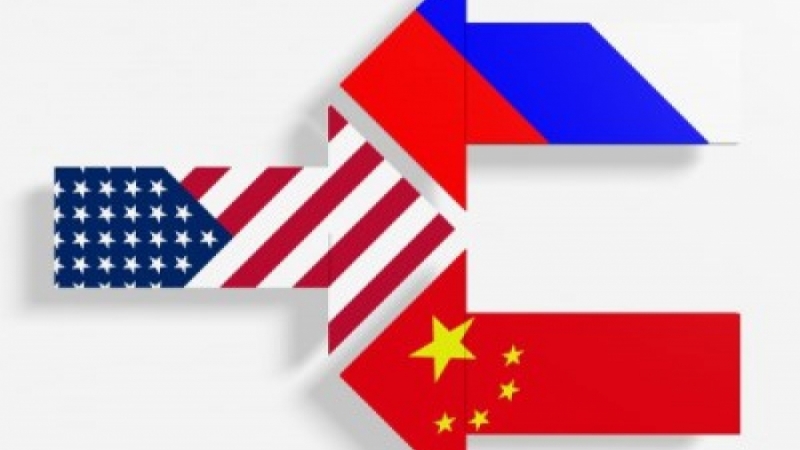US Threatens Russia and China
Rising powers undeterred by American belligerence
Empowering Weak & OppressedKevin Barrett
Shawwal 27, 1440 2019-07-01
News & Analysis
by Kevin Barrett (News & Analysis, Crescent International Vol. 48, No. 5, Shawwal, 1440)

In 2018, then-Defense Secretary James Mattis announced that the so-called “war on terrorism” — in reality a war on Islam for Israel — was no longer the USA’s top military priority. Henceforth the focus, Mattis said, would be “great power competition.” The new posture, aimed at containing the rise of Russia and China, was fleshed out in the Pentagon’s 2018 National Defense Strategy document.
The apparent shift in US posture reverts to the grand strategy outlined in the notorious March 1992 Paul Wolfowitz memo envisioning a permanently unipolar world. According to the Wolfowitz Doctrine, “Our first objective is to prevent the re-emergence of a new rival, either on the territory of the former Soviet Union or elsewhere, that poses a threat on the order of that posed formerly by the Soviet Union. This is a dominant consideration underlying the new regional defense strategy and requires that we endeavor to prevent any hostile power from dominating a region whose resources would, under consolidated control, be sufficient to generate global power.”
The above two sentences suggest that even in 1992, Russia and China were considered the biggest threats to US global domination. The “new rival on the territory of the former Soviet Union” can only be Russia. And the country “elsewhere” that could “dominate a region whose resources would, under consolidated control, be sufficient to generate global power” refers most obviously to China.
Twenty-seven years after the Wolfowitz memo leaked to the New York Times, US efforts to contain Russia and China are playing catch-up. After squandering credibility and $7 trillion on the 9/11 wars for Israel, the US finds itself facing a China whose real purchasing-power-adjusted GDP surpasses its own — and a re-emerging Russia whose lean mean military machine, alongside Islamic Iran and Hizbullah, was able to defeat the US proxy war on Syria.
The US, determined to maintain “full spectrum dominance” of the entire planet, is now menacing Russia and China with military saber-rattling and economic sanctions and tariffs. Perhaps the most alarming US move is its tightening the NATO nuclear noose around Russia’s neck. Even while it was being distracted by the phony “war on terror” the US continued to push NATO ever closer to Russia, encircling Moscow with ever-more-advanced first strike technology. Russian President Vladimir Putin responded last year by unveiling a new panoply of strategic weapons that appear to successfully counter the US first strike threat by ensuring that any US sneak attack, even if it succeeded in destroying most Russian land-based missiles, would still receive a devastating response. Among the new Russian weapons of deterrence are the Avangard Hypersonic Glide Vehicle that travels at Mach 20 and can hit anywhere on earth in less than 30 minutes, and the unstoppable submarine based “doomsday nuke drone torpedo” capable of creating seaboard-swamping radioactive tsunamis.
The US has encircled China, like Russia, with American military bases and naval forces. This year the US ramped up tensions in the South China sea by sending the 11th Amphibious Squadron’s warships into what Beijing claims is its territorial waters near the Paracel and Spratly artificial island chains. Simultaneously the US Air Force has been regularly flying nuclear-capable strike aircraft over the South China Sea while conducting drills featuring mock-up invasions of the Chinese islands.
Alongside the military threats, the US is conducting economic warfare aimed at containing Russia and China. Through a variety of means, including top-secret (and illegal) futures manipulation by the Plunge Protection Team, the US has replayed its 1980s strategy of attacking the Russian economy by keeping oil prices artificially low. And by playing The Oil Card, as James Norman’s title on the US takedown of the USSR through oil price manipulation put it, the US is also hurting Iran and Venezuela, both de facto Russian and Chinese allies in the struggle for a multipolar world.
The US is also waging economic warfare on Moscow and Beijing through sanctions and tariffs. According to the Washington Post, “Since 2014, the US has imposed travel bans, asset freezes and finance and trade restrictions against hundreds of Russian individuals and companies.” Putin’s closest allies and financial supporters, as well as some of the biggest Russian companies including Rosneft and Gazprom, have been sanctioned. But the sanctions have backfired by pushing Russia and China closer together. According to a Pentagon report, “In the wake of Western sanctions against Russia, China has increased investment in Russia’s economy.” Thanks in part to US sanctions, Russia-China trade has been growing at a rate of over 25% per year, reaching a record $108 billion last year.
The US is also sanctioning China, with similarly counterproductive results. On May 15 Trump issued an executive order banning trade with the Chinese telecom giant Huawei on the grounds that it represents a “national security threat.” The move will force Huawei to abandon its American suppliers, who provide about a third of its components, and accelerate its progress toward making all components domestically. This is in line with Beijing’s “made in China by 2025” initiative. Such self-sufficiency will make China stronger, not weaker.
At the same time he was sanctioning Huawei, Trump announced a new tariff attack on China. In mid-May Trump hiked tariffs on $200 billion worth of Chinese imports. The Chinese responded by raising tariffs on $60 billion worth of US goods. China also has other cards to play, including devaluing its currency the renminbi to spook global markets, imposing administrative punishments on US businesses operating in China, instituting an anti-US boycott, and dumping some or all of its $1 trillion in US treasuries to disrupt the American economy or even collapse the dollar.
Even if the current trade war ends in a truce, it will likely be temporary. The morally, spiritually, and economically-declining US is on a collision course with a rising China. Political scientist Graham Allison has coined the term “Thucydides trap” to describe how established powers routinely go to war with rising powers. In 12 of the 16 clearest cases, the result was all-out war.
Steve Bannon, who is widely credited (or blamed) with engineering Trump’s election, is on record stating that a US-China war is inevitable, “We’re going to war in the South China Sea in five to 10 years. There’s no doubt about that,” Bannon said in March 2016. On May 6 of this year, Bannon published an opinion piece in the Washington Post essentially demanding that China abandon its hybrid socialist-capitalist system in favor of unfettered capitalism opened to the predations of the West and the international bankers who own it. In order to force a Chinese surrender, Bannon foresees “a years-long economic and strategic war with China” in which compromise is futile, since China, according to Bannon, represents “the greatest existential threat ever faced by the United States.”
But how will Washington stop the rise of Russia and China when it can’t enforce its will on Syria, Iran, or Venezuela? Will it really be able to defeat an alliance of the biggest nations on earth (Russia geographically, China demographically and economically) when it can’t win wars against second- and third-tier countries like Afghanistan, Iraq, and Yemen?
The US ought to curtail its bullying and threats, abstain from launching further adventures in mass murder, and concentrate on setting its own house in order.




